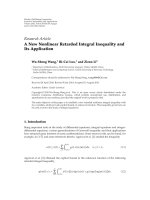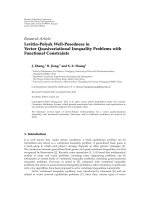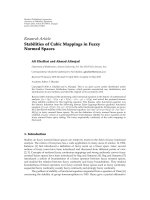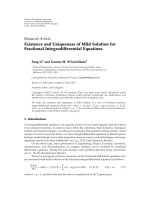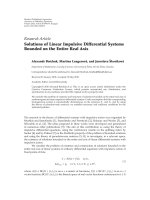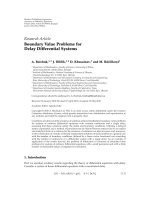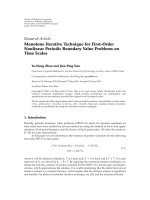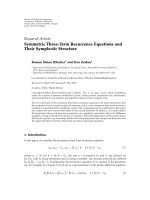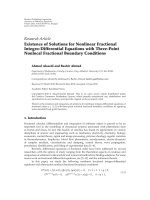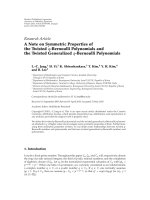Báo cáo sinh học: " Research Article Self-Tuning Synthesis Filter against Mutual Coupling and Interferences for GNSS and Its Implementation on Embedded Board" pot
Bạn đang xem bản rút gọn của tài liệu. Xem và tải ngay bản đầy đủ của tài liệu tại đây (8.55 MB, 13 trang )
Hindawi Publishing Corporation
EURASIP Journal on Advances in Signal Processing
Volume 2010, Article ID 123625, 13 pages
doi:10.1155/2010/123625
Research Article
Self-Tuning Synthesis Filter against Mutual Coupling and
Interferences for GNSS and Its Implementation on
Embedded Board
Chung-Liang Chang
Department of Biomechatronics Engineering, National Pingtung University of Science and Technology, Pingtung 91201, Taiwan
Correspondence should be addressed to Chung-Liang Chang,
Received 10 January 2010; Revised 2 May 2010; Accepted 9 June 2010
Academic Editor: George Tombras
Copyright © 2010 Chung-Liang Chang. This is an open access article distributed under the Creative Commons Attribution
License, which permits unrestricted use, distribution, and reproduction in any medium, provided the original work is properly
cited.
Traditional spatial-temporal adaptive signal processing techniques are often applied to conduct narrowband and wideband
interferences. However, its mitigation performance degrades greatly due to mutual coupling. To solve this problem, this paper
aims to utilize a spatial-temporal self-tuning synthesis filter capable of mutual coupling compensation and interference mitigation.
The spatial filter and temporal filter are to compensate for the effect of mutual coupling and interference mitigation, respectively.
Self-tuning mechanism is to adopt least square (LS) and minimum variable distortionless response- (MVDR-) based method
to adjust spatial and temporal weights of antenna array. The experiment platform is established by the embedded development
board. Simulation and experiment results demonstrate that the proposed method can effectively compensate for mutual coupling,
mitigate the cochannel interference up to 30 dB, and enhance the acquisition performance of receivers in global navigation satellite
system (GNSS).
1. Introduction
Satellites of global positioning system (GPS) operate on the
orbit 20200 kilometers high and the power of carrier for L1
band upon the ground is about
−130 dBm. In general, the
power of thermal noise can reach
−110 dBm. It indicates that
the power of GPS signal is lower than that of thermal noise.
Luckily, GPS adopts spread spectrum technique to acquire
sufficient gain for reception end to reconstruct signals.
However, if GPS is susceptible to unintentional or intentional
interference (jammer), it results in the difficulty in reception
and lock of GPS signals due to over strong magnitude of
interference, too wide bandwidth, and similarity in type of
modulation.
Typical interference mitigation techniques consist of
three types. The first is defined as antenna array model,
which utilizes multiple antennas to conduct the estimation
of interference direction and adjust the gain and phase of
antenna sets to null out interferences. The second is termed
precorrelation processing, which transfers high-frequency
to intermediate-frequency (IF) analog or digital signal and
then conducts signal processing regarding amplitude, time
domain, or frequency domain to decrease the impact of
interference [1, 2]. The last is called postcorrelation pro-
cessing, which adopts software-defined radio to integrate
GPS with other assisted navigation devices to enhance the
precision in navigation positioning. With regards to the
effect of interference mitigation, antenna array model is
most efficient. The precorrelation processing technique is
medium in effect and cost, but the reception circuit has
to be redesigned. The third technique is limited in effect
though it can employ available receivers in global navigation
satellite system (GNSS) and additional inertial navigation
components to aid positioning.
In a word, in terms of interference mitigation, the imme-
diate removal or mitigation of interferences upon the radio
frequency (RF) front-end of receiver yields a better result
than that upon rear-end of the receiver. Due to the specific
of geometric relations among each antenna component,
associated phase relation exists among received signals. The
use of spatial signal processing techniques can determine the
direction of interference source, and the adoption of adaptive
2 EURASIP Journal on Advances in Signal Processing
algorithm can establish spatial filter to eliminate the impact
of interference in GNSS receiver [3]. The insertion of time
domain filter to spatial signal processing can be extended
to spatial-temporal adaptive signal processing [4–6], which
performs by selecting the adaptive weights in order to
maintain the desired GPS signal and meanwhile minimize all
interferences. The key in spatial-temporal signal processing
is the use of adaptive algorithm to obtain the optimal weight,
which is multiplied with received signal of each antenna and
then summed altogether to yield the minimal error between
array output and design signal [7]. The constructed adaptive
beamforming is established through desired steering vector
without mutual coupling. Provid such ideal condition as
the equal spacing between antenna (half wave length) and
no consideration for antenna characteristics, and so forth,
many factors in reality generate mutual coupling, such as the
spacing between antenna less than half wavelength, thermal
noise, or the variation in radiation parameter and nonideal
characteristics in the design of antenna itself under high-
frequency environment.
Earlier, Sarkar and Sang ruji propose direct data domain
approach, which adaptively minimizes the interference
power and maintains array gain in the direction of the
signal [8], even if this method can cancel out undesired
interference sources. However, the effec t of mutual coupling
on beamforming results in the error in direction of arrival
(DoA). As a result, it causes error of steering vector, failure to
mitigate interference due to wrong DoA and strengthen the
direction gain of desired signal. Besides, the direction gain
does not null further.
An unfavorable impact of mutual coupling on the perfor-
mance of adaptive array algorithms has been reported [9, 10].
Friel and Pasala pointed out that the mutual coupling greatly
affects the signal-to-interference plus noise ratio (SINR) of
array output [10]. In 2000, Adve et al. utilized method of
moments (MOMs) as well as direct data domain technique
[9] to access mutual coupling between the elements of a given
array.
In order to reduce the adverse effects of mutual coupling
on antenna arrays, several mathematical models of mutual
coupling have been proposed in the literature review over the
last two decades [11–15]. In 1999, Svantesson estimates the
mutual coupling using electromagnetic concepts. Then, the
directions and coupling parameters are estimated utilizing
maximum likelihood method. However, it is not possible
neither to cancel out its effect nor to predict its variation
as the electromagnetic environment adjacent the antenna
changes. The autocalibration algorithm was employed to
compensate for mutual coupling in uniform and linear
arrays [13]. Both the DoAs of the incoming signals and
the unknown mutual coupling matrix of the array were
estimated in this algorithm.
The narrowband applications and proper compensation
of the induced surface current mutual coupling matrix
(MCM) can be estimated off-line [10, 14, 16]. The on-
line estimation should be utilized when the electromag-
netic environment that surrounds the antenna fails to be
appropriately compensated and the antenna operates with
wideband signal [13]. However, MCM is estimated either
on-line or off-line, whose structure is unchangeable. That
is, it is symmetr ic, per-symmetric, and Toeplitz. Suppose
MCM is known; mutual coupling can be mitigated to a
large scale through multiplication with the inverse of the
coupling matrix (suppose it to be full rank) [12]. Note that
in a large regular array, the edge effects may be ignored and
the mutual coupling matrix reduces to an identity matrix
except for a scaling factor. The above depiction shows that
MC compensation is operated in two steps.
The first step is to accurately estimate MCM. The second
step is the act of compensation, which is to premultiply
the data vector ot transmission weights by inverting MCM.
Thus, MC can be compensated utilizing the compensation
processor before the input signal is processed by adaptive
beamformer or DoA processor or after computation of the
transmission weights.
In this paper, we assume the MCM known a pr iori;
the proposed MC compensator utilizes least square (LS)
method depending on iteration process. Then, the esti-
mated mutual coupling matrix is adopted to reduce the
effect on interference mitigation. In addition, minimum
variance distortion less response- (MVDR-) based temporal
processing is employed to cancel wideband interference and
aid QR-decomposed operator to shorten computation time.
The novelty of this paper is that it is not only capable
of mitigating narrowband and wideband interferences but
also capable of providing a solution for mutual coupling
compensation. Besides, the proposed method is in reality
verified on Altera-embedded development board to evaluate
the effect of mutual coupling compensation and interference
mitigation.
The remainder of the pap er is organized as follows.
Section 2 describes the application of proposed method to
mutual coupling and interference. The simulation results are
demonstrated in Section 3. This is followed by a description
of the development of embedded system in Section 4
.The
experimental results of the antenna array against mutual
coupling and pseudolite-type interferences are also given
in this section. Finally, some conclusions are drawn in
Section 5.
2. Methodology
2.1. Signal Array Model. This section presents the mathe-
matical model of array output signal when the array signal
is influenced by mutual coupling. Firstly, the mathematical
model unsusceptible to mutual coupling is analyzed, which
has been completed [7]. The following then depicts the
mathematical model under the influence of mutual coupling
and illustrates the mutual coupling matrix model.
Assume that the real received baseband signal at time
instant k of N antenna elements with M-tap temporal filter
for each antenna is described by an N(M+1)
×1vectorshown
as follows:
x
(
k
)
= x
s
(
k
)
+ x
J
(
k
)
=
P
s
As(k)
x
s
(k)
+
J
j=1
P
j
B
j
i
j
(
k
)
+ C
(
k
)
,
(1)
EURASIP Journal on Advances in Signal Processing 3
where x(k)
= [x
a
(k) x
b
(k)]
H
depicts the incoming signal
samples on the taps of spatial-temporal filter. [
·]
H
denotes
the Hermitian transpose operator. x
a
(k) = [x
a
1
(k) ···
x
a
N
(k)] and x
b
(k) = [x
b
1
(k) x
b
2
(k) ··· x
b
M
(k)] are
the spatial and temporal signal
snapshots, respectively. x
b
m
(k) = [x
1m
(k)
··· x
Nm
(k)] and s(k) = [s
1
(k)s
2
(k) ··· s
M+1
(k)]
H
are both desired signals and essential modulated spread
codes subject to data modulation, time delay, Doppler
shift, and phase variation that uncorrelated with the
channel noise vector. P
s
and P
j
are the power of desired
signal and jth interference, respectively. i
j
(k) has the same
structure as s(k) , and J is the total number of interferences.
Each interference can be modeled as narrowband or
wideband signal. C(k)iszero-mean,temporallyandspatially
white noise with variance σ
2
I. A = I
(M+1)×(M+1)
⊗ a
θ
s
,φ
s
and B
j
= I
(M+1)×(M+1)
⊗ a
θ
j
,φ
j
,where⊗ denotes the
Kronecker product. a
θ
s
,φ
s
= [a
s
1
(k)a
s
2
(k) ··· a
s
N
(k)]
H
and a
θ
j
,φ
j
= [a
j
1
(k)a
j
2
(k) ··· a
j
N
(k)]
H
denote the N × 1
steering vector with respect to desired satellite and jth
interference source, respectively.
The array vector model depicted by (1)isvalidonlyfor
ideal arrays. For practical arrays, the simultaneous presence
of more than one sensor as well as objects adjacent to the
array accounts for the noted mutual coupling effect. In a
more realistic scenario, the signal received by one sensor
can be expressed as a linear combination of the wave fields
incidents onto all the sensors rather than associated with the
wave field incident on that sensor only. To take the coupling
effect into consideration, the arr ay signal model in (1)hasto
be modified by incorporating a matrix term called coupling
matrix. Therefore, the A and B
j
in the presence of mutual
coupling can be written as
A = I
(M+1)×(M+1)
⊗ Ma
θ
s
,φ
s
,
B
j
= I
(M+1)×(M+1)
⊗ Ma
θ
j
,φ
j
,
(2)
where M is an N
× N matrix that demonstrates the mutual
coupling effect, introduces the distortion of a mplitudes and
phases in elements of steering matrix, and depicts how the
individual antenna elements are coupled with one another.
Nevertheless, mutual coupling coefficients between two far
apart elements can be approximated to zero. Thus, it is
adequate to consider the coupling model with just a few
nonzero coefficients. The mutual coupling matrix (MCM)
can be given as follows:
[
M
]
pq
=
⎧
⎪
⎪
⎪
⎪
⎨
⎪
⎪
⎪
⎪
⎩
δ,
p − q
=
1,
1, p
= q,
0, other,
(3)
where [
·]
pq
indicates the coupling contribution of the qth
antenna to pth antenna and δ is the intensity of the received
power of its immediate neighbors.
Thus, the array signal vector in the presence of mutual
coupling can be rewritten as
x
(
k
)
=
P
s
As
(
k
)
+
J
j=1
P
j
B
j
i
j
(
k
)
+ C
(
k
)
,(4)
where
x = [x
a
(k) x
b
(k)]
H
is the same structure as (1).
Finally, it is possible to write the spatial covariance matrix of
the array sig nal vector in the absence and presence of mutual
coupling as
R
11
E
x
H
1
(
k
)
x
1
(
k
)
,
R
11
E
x
H
1
(
k
)
x
1
(
k
)
,
(5)
where
x
m
(k) = [x
1m
(k) ··· x
Nm
(k)] and E{·} denote
the expectation operator. Similarly, the temporal covariance
matrix of the array signal vector in the absence and presence
of mutual coupling is shown as follows:
R
bb
E
x
H
b
(
k
)
x
b
(
k
)
,
R
bb
E
x
H
b
(
k
)
x
b
(
k
)
.
(6)
2.2. Mutual Coupling Compensation and Interferences Mitiga-
tion. The rules in the design of adaptive antenna algorithm
can be applied in spatial and temporal domain. The structure
of an adaptive antenna is adapted through spatial filters
whose complex weights combine the signal from each
antenna element. Each antenna element is processed with
its own temporal filter, the outputs of which are joined
together to yield a single output signal. The weights are
selected to effectively null out interference while intentionally
retaining the desired signal. The adaptive nulling of the
antenna array is demonstrated by the capability to steer
several nulls (minimum of the radiation pattern) to the
interferences while keeping a maximum of the radiation
pattern toward the desired signal. However, the above
process of adaptive array algorithm is undertaken without
considering mutual coupling effect. To evaluate the effect
of mutual coupling and compensate for its influence, an
adaptive spatial filter with LS method is utilized to make up
for mutual coupling effect and a temporal filter with QR-
based MVDR beamformer is adopted to mitigate wideband
and narrowband interferences.
2.2.1. Mutual Coupling Compensation. It is shown from (2)
that when MCM is known, mutual coupling effect can be
easily null ed out by premultiplying the input steering vector
a
θ,φ
by the inverse of MCM (assuming that it is invertible).
Assume that the weight vector w
a
is susceptible to mutual
coupling; the estimated one is expressed by
w
a
= Mw
a
+ e,(7)
where e denotes the measurement error. The mutual cou-
pling M can be calculated by employing LS method as a
solution for the following optimization problem:
M = arg min
M
w
a
− Mw
a
2
2
,(8)
4 EURASIP Journal on Advances in Signal Processing
where
·
2
indicates the Euclidean norm, and w
a
= a
θ
s
,φ
s
denotes the receiver weight vector for nonadaptive array, or
w
a
= R
−1
11
a
θ
s
,φ
s
means the receiver optimum weight vector
for adaptive array. Thus,
M can be calculated through LS
method:
M = w
a
w
H
a
(w
a
w
H
a
)
−1
. (9)
2.2.2. MVDR Beamformer. In spatial-temporal processing,
the MVDR beamforming can minimize the combined output
from an antenna array, in a least square sense limited by
independent linear equality constraints (constraint opti-
mization), each of which relates to a selected look direction.
Suppose that the constraint is formulated in order to
minimize the variance (the average power) of a beamformer
output. Meanwhile, distortionless response is maintained
in particular direction (target direction of interest). Such a
solution is termed MVDR. The cost function is to minimize
the output power of array system given by
min
w
w
H
b
E
x
b
(
k
)
x
H
b
(
k
)
w
b
= w
H
b
R
bb
w
b
s.t. w
H
b
d
θ,φ
= 1,
(10)
where d
θ,φ
is NM×1 desired spatial-temporal steering vector.
Use the Lagrange multiplier operator, and the optimum
weight vector is show n as follows:
w
MVDR
=
R
−1
bb
d
θ,φ
d
H
θ,φ
R
−1
bb
d
θ,φ
. (11)
Many practical applications of MVDR beamformers require
online calculation of the weights based on (11). It indicates
that the covariance matrix in (6) should be estimated
and inverted online. Nevertheless, this process is high in
computational cost and it may be hard to estimate the sample
covariance matrix in real time if the number of samples NM
is large. Besides, the numerical calculation of the weights
w
MVDR
utilizing the expression (11) may be very unstable if
the sample covariance matrix is ill-conditioned. The use of
QR decomposition of the incoming signal matrix can yield a
numerically stable and computationally efficient algorithm.
This mat rix is decomposed as R
bb
= QR,whereQ denotes
the unitary matrix and R indicates the upper triangular
matrix. Thus, the QR-based algorithm for calculation of
beamformer weights consists of the following three stages.
Step 1. The linear equation system R
H
u
1
= d
θ,φ
is solved for
u
1
, and the solution is u
T
1
= (R
H
)
−1
d
θ,φ
.
Step 2. The l inear equation system R
H
u
2
= u
T
1
is solved for
u
2
, and the solution is u
T
2
= R
−1
u
T
1
.
Step 3. The weight vector is obtained as
w
MVDR
= u
T
2
/d
H
θ,φ
u
T
2
.
The Matlab’s QR decomposition function is utilized in
this paper.
2.3. Self-Tuning Synthesis Algorithm. To compensate for
mutual coupling effect and mitigate interferences, methods
described in Sections 2.2.1 and 2.2.2 are combined to
simultaneously solve these problems. Assume that the output
of the array system can be illustrated in the following:
y
(
k
)
= w
H
x
=
w
a
w
b
H
x
= w
H
a
x
1
+
M
m=2
w
H
m
x
m
,
(12)
where w
a
= [w
11
w
21
··· w
N1
]
H
and w
m
=
[w
1m
w
2m
··· w
Nm
]
H
are N × 1 spatial and temporal
weight vector, respectively, and the calculation method
is shown in Section 2.2.Thevectory(k) contains three
components consisting of signal, interference, and noise
sources. The objective of proposed method is to minimize
the following equation:
M, w
a
, w
b
=
min
w
a
,w
b
E
y
(
k
)
− d
(
k
)
2
=
min
w
a
,w
b
E
R
−1
11
a
θ
s
,φ
s
x
a
− R
−1
bb
d
θ,φ
×
d
H
θ,φ
R
−1
bb
d
θ,φ
−1
x
b
− d(k)
2
,
(13)
where d(k) is the ideal antenna array output. In practical
applications, R
11
and R
bb
are unattainable. Thus, the sample
covariance matrices
R
11
and
R
bb
are employed rather than
R
11
and R
bb
. Equation (9) is obtained through iterative
optimization method. Note that a
θ
s
,φ
s
and d
θ,φ
are both
vectors of desired signals but different only in size of
dimension. The following is a step-by-step description of
now to obtain the estimated
w
a
and w
b
in order to obtain
the estimated mutual coupling matrix
M iteratively.
Step 1. Use known desired array steering vector a
θ
s
,φ
s
to
estimate the
w
a
, and considering the w
a
as initial spatial
weight
w
a
(0).
Step 2. Use the estimated
w
a
(M +1)((M +1)thiteration)to
construct
w
b
at Mth iteration.
Step 3. Use (8) to estimate
M.
Step 4. Use (7) to estimate
w
b
with the estimated
M.
Step 5. If the algorithm converges, then stops. Otherwise, go
to Step 2 to continue.
2.4. Performance Criterion. The performance measures are
adopted to assess the performance of mutual coupling
compensation and beamforming technique. nth antenna in
EURASIP Journal on Advances in Signal Processing 5
(1) can be decomposed into three components: signal z
s
(k),
interference z
r
(k), and noise z
v
(k):
x
n
(
k
)
= z
s
(
k
)
+ z
r
(
k
)
+ z
v
(
k
)
. (14)
Similarly, the vector y(k)in(12) consists of three com-
ponents: desired signal y
s
(k), interference y
r
(k), and noise
y
v
(k) after the linear combination operation (12):
y
(
k
)
= y
s
(
k
)
+ y
r
(
k
)
+ y
v
(
k
)
. (15)
The input signal-to-interference plus noise ratio (SINR) is
considered as the ratio (in dB) between the desired signal and
other components, or
SINR
in
= 10 log
10
⎛
⎝
z
s
2
E
z
r
2
+ z
v
2
⎞
⎠
. (16)
The input interference-to-signal ratio (ISR) is defined as
ISR
= 10 log
10
z
r
2
z
s
2
. (17)
Use the superposition principle, and the SINR a t the
beamformer output can be evaluated as
SINR
out
= 10 log
10
⎛
⎝
w
H
z
s
2
E
w
H
z
r
2
+ w
H
z
v
2
⎞
⎠
. (18)
From (16)and(18), the improvement in SINR provided by
the beamformer can be defined as
SINR
imp
= SINR
out
− SINR
in
. (19)
This quality measure assesses the potential of the proposed
algorithm to eliminate the power of interference in the
incoming signal and meanwhile maintain the desired signal
power. Besides SINR improvement factor, the signal acqui-
sition margin (SAM) is utilized to determine the signal
acquisition threshold [3]. It is a measure of the signal and
noise peak values after correlation. Assume that A
s
is the
peak value of the GPS signal in the acquisition diagram after
correlation and A
v
is the peak value in correspondence to
interference and noise. The SAM is defined as
SAM
= 10 log
10
A
s
E{A
v
}
. (20)
Thus, a hig h SAM indicates a successful rate in signal
acquisition.
3. Numerical Examples
In this section, computer simulations are made to evaluate
the performance of the proposed methods. The performance
of proposed method and typical adaptive array technique
[8, 16] is compared and evaluated. Three cases of simulations
are presented for a 2
× 2and3× 3 uniform rectangular array
(URA). In the first scenario, the rectangular array opera ting
in nominal mode is demonstrated. The second depicts
a scenario where the interference is present and mutual
coupling is absent. The third indicates the array processing
under the condition of mutual coupling and interference.
The antenna locations (in meters) in half-wavelength (λ/2)
spacing with the ar ray operate at IF 4.092 MHz. Each antenna
has 5 taps delay a nd the direction of the desired signal is
known a priori. Let the desired signal-to-noise ratio (SNR)
in all simulations be
−20 dB. The intensity of the received
power of its immediate neighbors δ is between 0.1 and 0.5.
The number of antenna elements N is associated with the
number of broadband interferences that can be cancelled by
the spatial-temporal beamforming algorithm. In general, the
number of broadband interferences that can be eliminated
by the spatial-temporal filtering corresponds to N
−1. Three
scenarios with the main parameters illustrated in Ta ble 1 are
simulated. One desired sig nal at broadside (θ
= 40
◦
, φ =
120
◦
) and two directional broadband interference sources at
[(θ
= 40
◦
, φ = 15
◦
), (θ = 40
◦
, φ = 170
◦
) ] are generated
in the simulations where the desired signal and each of
the interference signals are uncorrelated. 100 Monte Carlo
simulations are conducted and the length of the available
data record is 40 ms.
Figure 1(a) illustrates the use of URA (2
× 2) array struc-
ture under ISR as 50 dB and shows the result of gain pattern
with/without the proposed algorithm. The gain pattern can
be illustrated when the spatial-temporal weight of proposed
method satisfies (13). The figure demonstrates that under
the effect of mutual coupling, the interference cannot be
fully mitigated due to the decrease of gain in the DoA of
desired signal and wrong direction of interference mitiga-
tion. Through mutual coupling compensation, the gain of
interference direction can be effectively mitigated and the
error between desired direction and simulated direction is
eliminated. On the other hand, the gain of desired direction
is enhanced. Figure 1(b) shows similar results in the use of
URA (3
×3) array structure, but only different in the increase
of space freedom regarding interference mitig- ation in
comparison with simulation results of URA (2
×2) st ructure.
Figure 1 demonstrates that Sarkar’s method can maintain the
direction gain of desired signal under mutual coupling effect.
On the contrary, the mitigation of direction gain regarding
interference signal is not effective. Figure 2 describes the plot
of SINR normalized to an asymptotic solution versus num-
ber of samples for 3
×3 URA. In these arrays, the estimates of
the improvement in SINR are assessed as a function of the
ISR and plotted in Figure 3. The figure illustrates that the
more the increase of ISR, the more the improvement of SINR
after decoupling and interference mitigation. This is more
obvious under 3
× 3 URA structure. The conjugate gradient
method is demonstrated in literature review [8].
4. Test Hardware and Experiment Results
This session depicts how embedded system is implemented
in proposed method with regards to mutual coupling
compensation and interference mitigation and meanwhile
presents how to construct an embedded system as a platform
combination antenna array modules to receive GPS signal.
6 EURASIP Journal on Advances in Signal Processing
0 60 120 180
−70
−60
−50
−40
−30
−20
−10
0
Interference φ (deg)
Array response (dB)
Ideal beamformer (w/o interferences)
Coupled pattern (with two interferences)
Adaptive array (Karkar's method)
Decoupled pattern (with two interferences)
(a) URA (2 × 2)
0 60 120 180
−100
−80
−60
−40
−20
0
Interference φ (deg)
Array Response (dB)
Ideal pattern (w/o interference)
Coupled pattern (with two interferences)
Adaptive array (Sarkar's method)
Decoupled pattern (with two interferences)
(b) URA (3 × 3)
Figure 1:Thebeampatternindifferent scenarios for ISR = 50 dB
Table 1:Parameterssetupoftestscenarios.
Number of antenna
element (URA)
Mutual coupling exist?
(Yes/No)
ISR
Interference
direction (θ
j
, φ
j
)
Desired GPS signal
direction (θ
s
, φ
s
)
Scenario 1
4(2
× 2)
No None None (40
◦
, 120
◦
)
9(3
× 3)
Scenario 2
4(2
× 2) No
10
∼80 dB
(40
◦
,15
◦
)
(40
◦
, 120
◦
)
9(3
× 3) No (40
◦
, 170
◦
)
Scenario 3
4(2
× 2) Yes
10
∼80 dB
(40
◦
,15
◦
)
(40
◦
, 120
◦
)
9(3
× 3) Yes (40
◦
, 170
◦
)
Table 2: Corresponding output signal.
SGN MAG Value
01+3
00+1
10
−1
11
−3
4.1. Hardware Description. The experiment structure
includes an antenna array platform and embedded system to
implement the proposed algorithm. The hardware structure
is illustrated in Figure 4. Four antennas make up the antenna
array platform in rectangular shape with the spacing between
each antenna as L1 half-wave length (9.5 cm). Each antenna
is, respectively, connected to four RF front-end modules and
the external oscillator and buffer can provide clock signal
for each module to simultaneously receive GPS signals. GPS
signal is converted to 2-bit digital intermediate frequency
(IF) for output through the analog-to-digital converter
Table 3: Exper i ment results for PRN 11(SAM detection threshold
= 5dB).
SAM
Without self-tuning
synthesis algorithm
With self-tuning
synthesis algorithm
ISR λλ/2 λ/4 λλ/2 λ/4
10 7.12 7.83 5.3 7.23 7.62 6.28
20 5.81 6.44 — 7.19 7.44 6.32
30 — 5.11 — 6.99 7.23 5.21
40 — — — 6.95 7.19 —
50 — — — 6.91 7.15 —
(ADC) in each module. The output signal is sent to the
development board of embedded system to conduct mutual
coupling compensation and interference mitigation and the
proposed method can be implemented through embedded
system development kit. The computer then verifies and
analyzes whether the received signal can efficiently mitigate
interference and compensate mutual coupling through
EURASIP Journal on Advances in Signal Processing 7
0
20 40 60 80 100
−40
−30
−20
−10
0
Snapshots
Normalised SINR (dB)
Without couple effect
Coupled array (δ = 0.5)
Coupled array (δ = 0.2)
Adaptive array (Karsar's method)
Decoupled array
Figure 2: Normalized SINR in the array output before and after
decoupling (URA 3
× 3).
Table 4: C/No results with/without proposed method.
PRN
Without proposed algorithm
With
proposed
algorithm
A1 A2 A3 A4
C/No (dB-Hz)
4
38.41 38.30 36.62 38.31 38.81
8
37.22 34.17 35.44 36.45 38.46
11
32.24 35.34 34.71 32.75 39.05
17
— — 33.43 — 36.87
20
36.28 37.14 36.64 35.75 38.52
25
32.76 36.82 37.70 38.11 39.30
27
— 35.22 — 35.23 39.56
28
36.80 36.49 — — 37.67
19
36.88 37.31 — 34.11 38.26
embedded system to provide acquisition and t racking for
satellite positioning. The function of each component in the
system structure is demonstrated as follows.
4.1.1. GPS Antenna. The experiment adopts four MK-76
GPS antennas [17], with each antenna gain as 26 dB and
noise figure as 2.0 dB.
4.1.2. RF Front-End. The RF front-end module consists of
RF front-end IC produced by merged Nemerix Inc., RF
low noise amplifier (LNA), mixer and 2-bit A DC module.
The ADC output is “SIGN” and “MAG” bit data output
which has to be transferred in order to correspond to
suitable voltage level in embedded development board.
The corresponding relation is illustrated in Table 2.The
experiment requires at least four RF front-end modules with
the sampling frequency as 16.368 MHz and digital IF as
4.092 MHz.
4.1.3. D igital Signal Processing Development Kit (DSP
DEVKIT-2S60). The DSP Development Kit, Stratix II
Edition, offers engineers with a complete system-on-a-
programmable-chip (SoPC) solution. The kit is developed
and designed by Altera company, which adopts high-
performance FPGA DSP application and structured applica-
tion specific integrated circuit (ASIC) platform. The com-
plete Altera DSP Development Kit includes DSP develop-
ment board and Quartus II 6.0, SoPC Builder 6.0, and NiosII
6.0 in software. The major components in development
board consist of Nios II core processor, on-chip memory,
serial peripheral interface (SPI), universal asynchronous
receiver/transmitter (UART), direct memory access (DMA)
controller, parallel input/output (I/O) interface, avalon bus,
and Timer, which are integra ted in an Altera’s Stratix II FPGA
device.
The Stratix II EP2S60 DSP de velopment board is used in
this paper and this board provides a hardware platform that
designers can utilize to star t developing DSP systems accord-
ing to Stratix II devices. Combined with DSP intellectual
property (IP) from Altera and Altera megafunction partners
program (AMPP
SM
) partners, users can quickly develop
powerful DSP systems. The development boa rd includes
some memories and hardware transmission interface, such
as 32 MB synchronous dynamic random access memory
(SDRAM) and 1 MB static random access memory (SRAM),
joint test action group (JTAG), and RS232, which employs
SoPC Builder to configure the system on a chip and also
generates the Avalon switch fabric to connect all ports. More
detailed information can be found in [18].
4.2. Experiment System Establishment. With respect to
embedded system, the inbuilt Megafunction in Quartus
II [19] is employed to design spatial-temporal st ructure
and the inbuilt design tool SoPC builder in Quartus II is
adopted to construct Nios II CPU [20] for communication
with peripheral interface. The self-tuning synthesis filter
algorithm adopts C-language to write and implement in Nios
II integrated device electronics (IDE) [21]. The proposed
algorithm is to adjust weight, estimate mutual coupling
matrix, and have the value sent to the designed spatial-
temporal structure in Quartus II to allow mutual coupling
compensation towards GPS signal and mitigation towards
noise, interference.
The following context wil l describe how to apply
embedded development board to implement the proposed
algorithm and conduct signal acquisition analysis of the
processed signal using Matlab software.
Step 1. Four RF front-end modules are connected to four
antennas, respectively, on experiment platform. Then, the
self-designed circuit interface board is inserted to I/O inter-
face of embedded development board. Then, the Quartus
II software is utilized to construct transmission interface
8 EURASIP Journal on Advances in Signal Processing
0 20406080
0
20
40
60
80
ISR (dB)
SINR improvment (dB)
Without couple effect
Coupled array
Adaptive array (Karsar's method)
Decoupled array (proposed)
(a) URA 2 × 2
020
40
60 80
0
20
40
60
80
ISR (dB)
Without couple effect
Coupled array
Adaptive array (Sarkar' method)
SINR improvment (dB)
Decoupled array (proposed)
(b) URA 3 × 3
Figure 3: SINR improvement for 2 × 2 and 3 × 3URAstructure.
RAM
Avalon switch fabric
Data input
peripheral
DMA
Data output
peripheral
Nios II/quartus II software
Stratix II FPGA device
DMA
NiosII core
processor
FPGA
co-processor
SOPC
builder
TCXO
Stratix II EP2S60 DSP development board
RF front-end modules
GPS Signal
acqui is tion/tracking
A1
A2
A3
A4
ADC
ADC
ADC
ADC
PLL
PLL
PLL
PLL
NJ1006
NJ1006
NJ1006
NJ1006
CLK
CLK
CLK
JTAG controller
DMA
DMA
Interface board
Figure 4: Antenna array experiment system.
between RF front-end module and embedded board. The
goal is to allow embedded board to receive GPS signals
from RF front-end modules. First, the pin name of signal
input is set and its location is assigned to the point of
expansion Interface in DSP development board. Then, the
“altpll” megafunction is added in the top-level Quartus II
design to create a phase-locked loop (PLL) clock output.
This process constitutes the transmission interface. Each
RF front-end module outputs 2-bit digital signal. Thus,
an antenna array composed of four antennas makes 8-bit
output. The transmission interface is to test whether the
embedded system can accurately receive GPS data without
self-tuning algorithm.
The Quartus II software is adopted to construct spatial-
temporal filter where each antenna is composed of 5-tap
finite impulse response (FIR) filter. Hence, four antenna sets
make up 20 taps. Figure 5 demonstrates the structure of
self-tuning filter. RF front-end modules transfer incoming
signal to IF digital signal, which is sent to embedded
development board for spatial-temporal signal processing.
The input data has to multiply the weight of real and image,
respectively, after each delay time, the result of which is
summed altogether for output.
Step 2. The spatial-temporal module constructed in Quartus
II software is incorporated to user logic program and
EURASIP Journal on Advances in Signal Processing 9
Spatial-temporal
Synthesis filter output
Real weight
Image weight
GPS signal
5-tap
Antenna 1
Antenna 2
Antenna 3
Antenna 4
Figure 5: Self-tuning synthesis filter structure.
Interface to user logic
Quartus schematic file
Port setup
Figure 6: SoPC builder interface.
10 EURASIP Journal on Advances in Signal Processing
Figure 7: Photo of experiment location.
connected to Avalon. The accomplishment in setting up
related parameter can yield CPU core designed by user
(as shown in Figure 6). The translation starts to execute
upon the incorporation of designed Nios CPU to the
constructed spatial-temporal structure in Quartus II and the
joint connection between them. If no error occurs in the
translation, the
∗
.sof file generates and is written to FPGA
board.
Step 3. Select a spacious ground and employ the designed
platform to receive GPS signal. The length of each data
reception is about 3 ms. Have the received data sent to
spatial-temporal processing module in Quartus II for signal
processing. Through the operation of dynamic memory
access (DMA), store the 3ms received GPS signal to external
SDRAM for Nios II to execute adaptive algorithm.
SoPC Builder database consists of a processor and a large
amount of IP core. This system adopts Nios II processor,
DMA, SDRAM, user logic, JTAG, and UART and has the
constituted spatial-temporal filter modules in Quartus II
incorporated into “User logic”, which is connected to Avalon
shown in Figure 6. The designed CPU is generated as the
transmission interface between Quartus II and Nios II.
The calculated weights will be delivered to spatial-temporal
module in Quartus II through Nios II CPU by w ay of
iteration. After several iterations, Quartus II performs to
acquire the output data of spatial-temporal processing.
Step 4. Conduct signal acquisition analysis of the processed
data using Matlab software.
4.3. Results. The location of experiment test is selected at
longitude 22.9
◦
and latitude 120.2
◦
, shown in Figure 7.The
observable GPS satellites are depicted in the sky plot of
Figure 8. Eight GPS satellites are observed. The location of
the interferer is at azimuth 312
◦
and elevation 53
◦
and ISR
is about 30 dB. The initial location of each satellite can be
obtained by YUMA data [22]. The data is stored in random-
access memory (RAM) on-chip in development board, and
the initial weight value is also stored in the RAM on-
chip. In the experiment, the embedded development board
is switched on to receive GPS signals and then conducts
90
60
30
270
240
210
0
330
300
180
150
120
30
0
E
W
N
S
4
8
11
17
19
20
25
27
28
Jammer
PRN11
0
Figure 8: Sky plot of GPS satellites and near-field pseudolite
interference.
iteration process through proposed algorithm when the
weight value converges. The output data is postprocessed by
the Matlab software for signal acquisition. The nominal SAM
with regards to each satellite is computed. The cochannel
interference is then switched on and the data consisting
of components such as GPS satellites, the interference, and
noises is processed by the proposed algorithm. Figure 9
shows the digital waveform from four RF front-end modules
in system PLL. The figure illustr ates that the GPS signal
from each antenna is successfully received by embedded
development board. Table 3 describes the signal acquisition
result of PRN 11 with/without the proposed algorithm
under different antenna spacing with mutual coupling
matrix known a priori. The table illustrates that the use
of proposed algorithm can lower the impact of decreased
acquisition performance due to the antenna spacing less than
λ/2. Figure 10 shows the signal acquisition result of each
antenna (the antenna spacing is λ) regarding PRN 11 without
proposed method and it indicates the coexistence of near-
field pseudolite interference (ISR
= 30 dB) and true PRN
11 satellite signal. The figure presents that signal acquisition
process locks cochannel interference signals, which leads to
error in signal tracking and increase in positioning error.
The acquisition result of antenna 2 (A2) differs due to
unsimultaneous reception time of each antenna, incoherent
antenna characteristics, or phase error caused by mutual
coupling. Nevertheless, it is for certain that the acquisition
magnitude of interference signal is far stronger than that of
live satellite signal (PRN 11).
Figure 11 describes that when the weight value of
spatial-temporal filter converges after iteration of proposed
algorithm, the acquisition magnitude of interference signal
is weak. This is because the direction gain of interference has
been nulled. Figure 12 shows gain pattern after beamforming
and it indicates that the proposed algorithm can efficiently
EURASIP Journal on Advances in Signal Processing 11
Figure 9: The waveforms of hardware output.
Desired
signal
PRN 11
Jammer
PRN 11
Code phase
= 423.1875
1
0.5
0
5
0
−5
0
500
1000
Doppler shift = 4000 Hz
(a)
Desired
signal
PRN 11
Jammer
PRN 11
Code phase
= 423.1875
1
0.5
0
5
0
−5
0
500
1000
Doppler shift = 4000Hz
(b)
Desired
signal
PRN 11
Jammer
PRN 11
1
0.5
0
5
0
−5
0
500
1000
Code phase
= 423.125
Doppler shift
= 4000 Hz
(c)
Desired
signal
PRN 11
Jammer
PRN 11
Code phase
= 423.1875
1
0.5
0
5
0
−5
0
500
1000
Doppler shift
= 4000 Hz
(d)
Figure 10: Acquisition result for antenna 1 (a), antenna 2 (b), antenna 3 (c), and antenna 4 (d).
12 EURASIP Journal on Advances in Signal Processing
Doppler shift = 1750 Hz
1
0.8
0.6
0.4
0.2
0
10
5
0
−5
−10
0
200
400
600
800
1000
Doppler o
ff
s
e
t (KHz)
Code phase(chip)
Code phase = 784.375
PRN11
C/No
= 39.056 dB-Hz
Figure 11: Acquisition result for PRN 11 using proposed algorithm.
90
60
30
270
240
210
0
330
300
180
150
120
30
0
E
W
N
S
4
8
11
17
19
20
25
27
28
Jammer
PRN11
0
0
−5
−10
−15
−20
−25
−30
−35
−40
−45
−47.4dB
Figure 12: Gain pattern of antenna array.
mitigate cochannel interference (jammer PRN 11). The fig-
ure demonstrates that the direction gain of interference has
been nulled to
−47.4 dB. The direction gain of desired signals
such as PRN 11, 28, and 17 is somewhat influenced (about
−4∼−11 dB) whereas that of other satellites is between 0∼
−
6 dB. Through the direction gain of PRN 11, 28, and 17
is somewhat influenced; their carrier-to-noise ratio (C/No)
values calculated as 39.05, 37.67, and 36.87 and shown in
Table 3 are sufficient to provide signal tracking. In Tab le 4 the
use of self-tuning synthesis algorithm does indeed enhance
the C/No of each satellite.
5. Conclusion
This paper proposes a self-tuning synthesis algorithm to
simultaneously compensate for mutual coupling effect and
mitigate interference. Simulation and experiment results are
demonstrated to verify the feasibility of proposed method.
In simulation, 2
× 2and3× 3URAstructuresareadoptedto
analyze the performance of proposed algorithm, respectively.
The simulation result indicates that 2
× 2and3× 3URA
can effectively compensate for mutual coupling effect (the
maximum tolerable value is δ
= 0.5). With respect to
interference mitigation for 2
× 2 URA, the SINR improve-
ment reaches 5.5
∼ 60.2 dB with ISR between 20 ∼ 80 dB.
Regarding 3
×3 URA, the SINR improvement reaches 13.2 ∼
70.1 dB. The use of 3 × 3 URA structure outperforms that
of 2
× 2 URA structure. In addition, the more the increase
of ISR, the more the improvement of SINR after decoupling
process. This paper also constructs an SoPC-embedded
experiment platform to verify the proposed method. As for
the SoPC development system utilized in this paper, the
design of point-to-point connection between logic gates can
be adopted in Quartus II hardware. Thus, it saves the trouble
of writing hardware language and the graphic user interface
(GUI) is more accessible to users. Besides, the adoption of
Nios II IDE in software is compatible to C-language, which
makes it easier to write algorithm.
However, in consideration of cost, this paper utilizes 2
×2
structure to analyze the performance of proposed algorithm
and employ an embedded system to develop this algorithm
in experiment. Due to the limitation in hardware, the use of
only five delay taps leads to the confinement of performance
in interference mitigation to 30 dB. The experiment also
analyzes the effect of different antenna spacing on the
performance of proposed algorithm. The results reveal that
the proposed method can efficiently compensate for mutual
coupling caused by narrower antenna spacing even if it is λ/4.
Acknowledgments
The author would like to thank the mechatronics laboratory,
National Cheng Kung University to provide the instruments
to conduct experiment and National Science Council in
Taiwan to support this research under Grant NSC 98-2218-
E-020-003.
References
[1] J. J. Spilker and F. D. Natali, “Interference effects and miti-
gation techniques,” in Global Positioning System: Theory and
Applications, B. W. Parkinson and J. J. Spilker, Eds., American
Institute of Aeronautics and Astronautics, Washington, DC,
USA, 1996.
[2] C. L. Chang and J. C. Juang, “Performance analysis of
narrowband interference mitigation and near-far resistance
scheme for GNSS receivers,” Signal Processing,vol.90,no.9,
pp. 2676–2685, 2010.
[3] J C. Juang and C L. Chang, “Performance analysis of
GPS pseudolite interference mitigation using adaptive spatial
beamforming,” in Proceedings of the Annual Meeting of the
Institute of Navigation, pp. 1179–1187, Cambridge, Mass,
USA, June 2005.
[4] D. H. Johnson and D. E. Dudgeon, Array Signal Processing:
Concepts and Techniques, Prentice Hall, Upper Saddle River,
NJ, USA, 1993.
EURASIP Journal on Advances in Signal Processing 13
[5] S J. Kim and R. A. Iltis, “STAP for GPS receiver synchroniza-
tion,” IEEE Transactions on Aerospace and Electronic Systems,
vol. 40, no. 1, pp. 132–144, 2004.
[6] B. Allen and M. Ghavami, Adaptive Array Systems: Fundamen-
tals and Applications, John Wiley and Sons, New York, NY,
USA, 2005.
[7] C L. Chang and J C. Juang, “Effect of array configurations
on the performance of GNSS interference suppression,”
International Journal of Control, Automation and Systems, vol.
6, no. 6, pp. 884–893, 2008.
[8] T. K. Sarkar and N. Sangruji, “Adaptive nulling system
for a narrow-band signal with a look-direction constraint
utilizing the conjugate gradient method,” IEEE Transactions on
Antennas and Propagation, vol. 37, no. 7, pp. 940–944, 1989.
[9]I.J.GuptaandA.A.Ksienski,“Effect of mutual coupling
on performance of adaptive arrays,” IEEE Transactions on
Antennas and Propagation, vol. 32, no. 5, pp. 785–791, 1983.
[10] E. M. Friel and K. M. Pasala, “Effects of mutual coupling on
the performance of STAP antenna arrays,” IEEE Transactions
on Aerospace and Electronic Systems, vol. 36, no. 2, pp. 518–
527, 2000.
[11] T. Svantesson, “Modeling and estimation of mutual coupling
in a uniform linear array of dipoles,” in Proceedings of the
IEEE International Conference on Acoustics, Speech, and Signal
Processing (ICASSP ’99), pp. 2961–2964, Phoenix, Ariz, USA,
March 1999.
[12] H. Steyskal and J. S. Herd, “Mutual coupling compensation
in small array antennas,” IEEE Transactions on Antennas and
Propagation, vol. 38, no. 12, pp. 1971–1975, 1990.
[13] F. Sellone and A. Serra, “A novel online mutual coupling
compensation algorithm for uniform and linear arrays,” IEEE
Transactions on Signal Processing, vol. 55, no. 2, pp. 560–573,
2007.
[14] Z. Huang, C. A. Balanis, and C. R. Birtcher, “Mutual coupling
compensation in UCAs: Simulations and experiment,” IEEE
Transactions on Antennas and Propagation, vol. 54, no. 11, pp.
3082–3086, 2006.
[15] C. L. Chang and J. C. Juang, “A new pre-processing approach
against array uncertainty for GNSS,” in Proceedings of the
IEEE/ION PLANS, pp. 892–897, Monterey, Calif, USA, May
2008.
[16] R. S. Adve and T. K. Sarkar, “Compensation for the effects of
mutual coupling on direct data domain adaptive algor ithms,”
IEEE Transactions on Antennas and Propagation, vol. 48, no. 1,
pp. 86–94, 2000.
[17] Sanav. San Jose Technology, Inc., />[18] Altera Corporation, “Nios development board Stratix II
edition ref. manual,” 2006.
[19] Altera Corporation, “Quartus II development software ver.
5.1,” 2004.
[20] Altera Corporation, Nios II Processor Reference’s Handbook,
2004.
[21] Altera Corporation, Nios II Software Developer’s Handbook,
2004.
[22] Navigation Center, />=
gpsAlmanacs.
